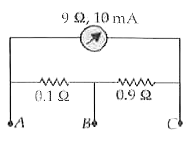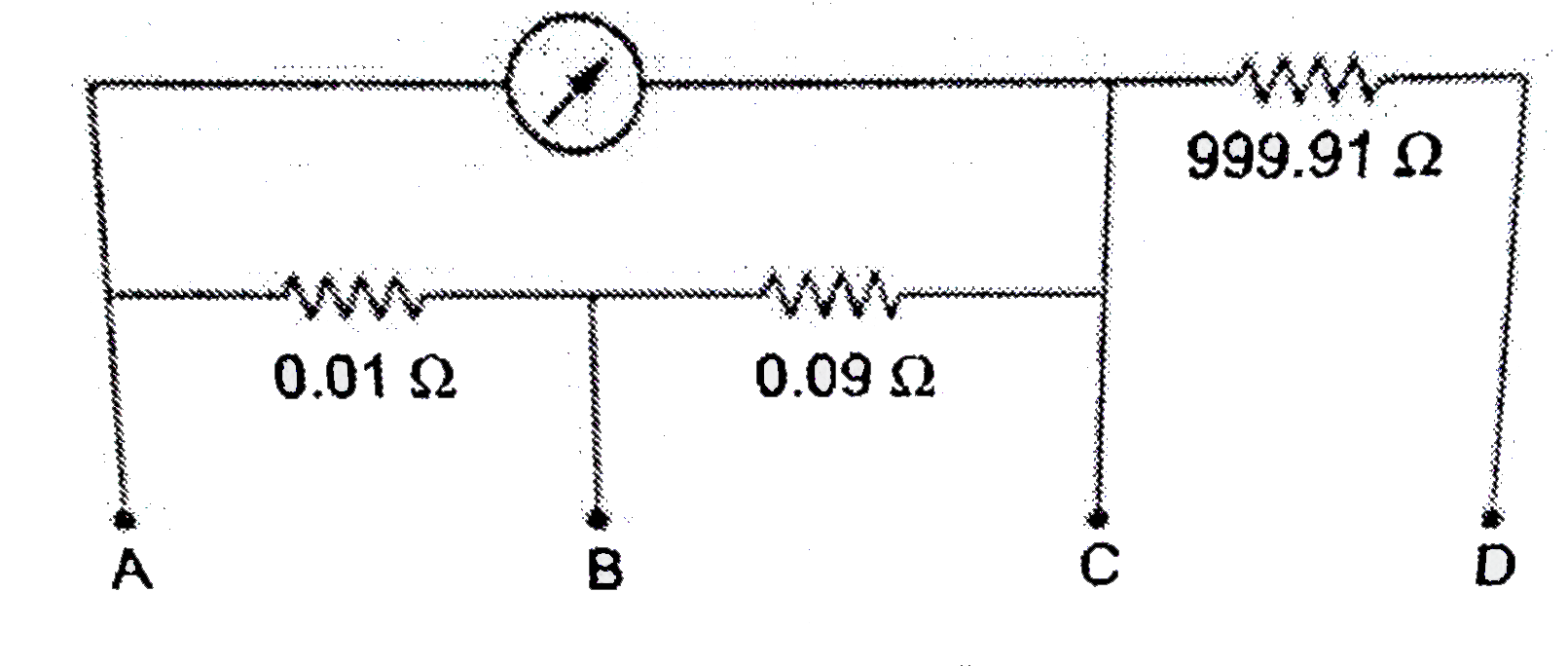A milliammeter of range 10 mA and resistance 9 Ω is joined in a circuit as shown in the figure. The metre gives full scale deflection for current / when A and B are used as its terminals, i.e., current enters at A and leaves at BC is left isolated). The value of /is

100mA
900Ma
1A
1.1A
The correct Answer is:C
Ig=10mA=0.01A
VA−Vg=(I−Ig)(0.1)=Ig×9.9
or 1×0.1=Ig×10
∴I=0.01×100.1=1A

Topper's Solved these Questions
- MAGNETIC EFFECTS OF CURRENT AND MAGNETISMBOOK - MTG GUIDECHAPTER - MAGNETIC EFFECTS OF CURRENT AND MAGNETISMEXERCISE - NEET CAFE (TOPICWISE PRACTICE QUESTIONS)(CURRENT LOOP AS A MAGNETIC DIPOLE AND ITS MAGNETIC DIPOLE MOMENT )
8 Videos
- MAGNETIC EFFECTS OF CURRENT AND MAGNETISMBOOK - MTG GUIDECHAPTER - MAGNETIC EFFECTS OF CURRENT AND MAGNETISMEXERCISE - NEET CAFE (TOPICWISE PRACTICE QUESTIONS)(MAGNETIC DIPOLE MOMENT OF A REVOLVING ELECTRON)
6 Videos
- MAGNETIC EFFECTS OF CURRENT AND MAGNETISMBOOK - MTG GUIDECHAPTER - MAGNETIC EFFECTS OF CURRENT AND MAGNETISMEXERCISE - NEET CAFE (TOPICWISE PRACTICE QUESTIONS)(TORQUE ON A CURRENT LOOP IN A MAGNETIC FIELD)
5 Videos
- ELECTROSTATICSBOOK - MTG GUIDECHAPTER - ELECTROSTATICSEXERCISE - AIPMT/NEET (MCQ.s)
34 Videos
- OPTICSBOOK - MTG GUIDECHAPTER - OPTICSEXERCISE - AIPMT/NEET
55 Videos
Similar Questions
A milliammeter of range 10mA and resistance 9Ω is joined in a circuit as shown. The metre gives full-scale deflection for curretn I when A and B are used as its terminals, i.e., current enters at A and leaves at B (C is left isolated). The value if I is

View SolutionA milli- ammeter of range 10mA and resistance 9Ω are joined in a circuit as shown in the fig. The meter gives full scale deflection, when current in the main circuit is I, and A and D are used as terminals. The value of I is

View Solution
Knowledge Check
A milliammeter of range 10mA and resistance 9Ω is joined in a circuit as shown. The metre gives full-scale deflection for curretn I when A and B are used as its terminals, i.e., current enters at A and leaves at B (C is left isolated). The value if I is
 A100mAB900mAC1AD1.1A
A100mAB900mAC1AD1.1AA milli- ammeter of range 10mA and resistance 9Ω are joined in a circuit as shown in the fig. The meter gives full scale deflection, when current in the main circuit is I, and A and D are used as terminals. The value of I is
 A1.09AB10.9 ACzeroD0.109 A
A1.09AB10.9 ACzeroD0.109 AA milli-ammeter of range 10mA and resistance 9Ω is joined in a circuit as shown in the figure. The meter gives full scale deflection, when circuit in the main circuit is 'I' and A and D are used as terminals. The value of I is
 A1.09AB10.9ACzero.D0.109A
A1.09AB10.9ACzero.D0.109A
Electrical multimeters, or multitesters, are widely used by technicians when working with electrical and electronic circuits. In this instrument, a single milliammeter connected through different resistances is used to measure currents, potential differences and resistance over different ranges.
Current always enters the multimeter at the same terminal, A, and then passes through the milliammeter as well as through other resistances, placed in series with or parallel to it. The choice of the terminal at which current leaves the instrument decides its role (ammeter, voltemeter, etc.) and its range (maximum current or voltage which it can measure).
The milliammeter shown in the circuit has a coil (or internal ) resistance of 0.9ω and gives the full-scale deflection for a current of 10mA.

If A and B are used as the terminals of the multimeter, i.e., current enters at A and leaves at B, it will function as an ammeter of range
View SolutionElectrical multimeters, or multitesters, are widely used by technicians when working with electrical and electronic circuits. In this instrument, a single milliammeter connected through different resistances is used to measure currents, potential differences and resistance over different ranges.
Current always enters the multimeter at the same terminal, A, and then passes through the milliammeter as well as through other resistances, placed in series with or parallel to it. The choice of the terminal at which current leaves the instrument decides its role (ammeter, voltemeter, etc.) and its range (maximum current or voltage which it can measure).
The milliammeter shown in the circuit has a coil (or internal ) resistance of 0.9ω and gives the full-scale deflection for a current of 10mA.

If A and C are used as the terminals of the multimeter, i.e., current enters at A and leaves at C, it will function as an ammeter of range
View SolutionElectrical multimeters, or multitesters, are widely used by technicians when working with electrical and electronic circuits. In this instrument, a single milliammeter connected through different resistances is used to measure currents, potential differences and resistance over different ranges.
Current always enters the multimeter at the same terminal, A, and then passes through the milliammeter as well as through other resistances, placed in series with or parallel to it. The choice of the terminal at which current leaves the instrument decides its role (ammeter, voltemeter, etc.) and its range (maximum current or voltage which it can measure).
The milliammeter shown in the circuit has a coil (or internal ) resistance of 0.9ω and gives the full-scale deflection for a current of 10mA.

If A and D are used as the terminals of the multimeter , i.e., current eneters at A and leaves at D, it will function as a voltmeter of which range?
View SolutionA galvanometer of resistance 20Ω is to be converted into an ammeter of range 1 A . If a current of 1 mA produces full scale deflection, the shunt required for the purpose is
View SolutionA milliammeter of resistance 5 ohm gives a full scale deflection for a current of 15 mA. If the mulliammeter is to be used to measure current upto 1.5 A, then the resistance that must be attached to the milliammeter is
View Solution
